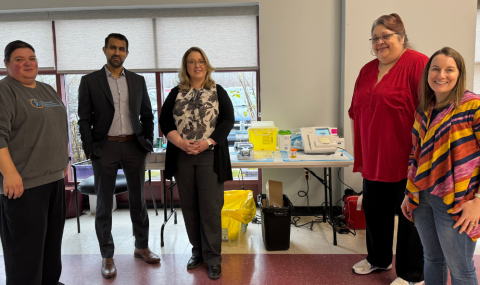Back to Cardiac Tests & Procedures
Introduction
An echocardiogram is an ultrasound of the heart. It is very similar to an ultrasound of an unborn baby. The test shows moving images of your heart and takes pictures. This will help your doctor evaluate your heart's health. A technologist uses a gel to slide a microphone-like device over the chest area. This provides a live picture of your heart and valves. No radiation is involved in heart ultrasound.
You may need this test if you have had chest or upper arm pain, a heart murmur, a heart attack, a heart defect, and/or a history of heart disease.
Risk Factors
There are no complications related to this test and everyone can have this test.
What to Expect Before the Echocardiogram
There is no special preparation required for an echocardiogram. You should come as you are and eat or drink as you normally do. If you take medications, you should continue to take them as normal unless your doctor specifies otherwise. You should plan on being at the Echocardiography Lab for about forty-five minutes to one hour.
Upon arrival on the fifth floor, the staff at the desk will greet you and ask you to register. The staff may ask you for additional information. They may also ask that you provide a prescription or order for your exam, your health card and the hospital blue card. The staff will then take you to the ultrasound room. The room will be dimly lit and will contain an examination bed and an ultrasound machine. You may be asked a few questions by the Sonographer such as why you need the test, if you have had this tests before, and if you have ever had open heart surgery. Usually, a brief explanation of the procedure will be given.
What to Expect During the Echocardiogram
You will be asked to remove your clothing from the waist up. Women can wear a gown during the test. You will be asked to lie down on your left side on the exam table. The Sonographer will then attach electrodes to your chest with simple tape. He or she will then attach ECG lead wires to these electrodes. The lights may be dimmed to allow the Sonographer to see the monitor better.
The Sonographer will put an ultrasound gel onto a microphone-like device called a transducer. The transducer sends and receives the harmless ultrasound waves between your body and the machine. The gel allows the ultrasound beams to go through your chest wall so that it he or she can "see" your heart.
The Sonographer collects images of your heart in a systematic way. He or she will move the transducer around on your chest, stomach, and neck. The Sonographer sees the images on a monitor. At certain key locations or "views", he or she will take recordings of your heart. These recording will be reviewed at a later time. During a recording, you may be asked to change your position and to hold your breath. This allows the Sonographer to get the best pictures. Sometimes, the Sonographer may push the transducer more firmly against your skin. Please let him or her know if this becomes uncomfortable.
You should try to stay still and quiet during the exam. The imaging will take about 30 to 45 minutes. Often, the Sonographer will review the study with a supervisor or physician while you are still in the room. You should not be alarmed. The Sonographer frequently relies on the advice of others, as the test can be complex.
Structures will be displayed in "real-time" and appear as white moving objects on the screen. For example, the valves of the heart will look like white flap-like moving structures. Areas of the heart where there is fluid or blood look black on the screen.
During the exam, you will notice the Sonographer placing marks on the screen with small computer calipers. The Sonographer uses the calipers to perform various measurements of the size, function and blood flow of the heart.
An echocardiogram exam usually includes a Doppler recording of the blood movement or flow within the heart. When color flow Doppler is used in the exam, it will appear as different colors moving within the white and black images on the monitor. The different colors represent the different speeds and directions of blood flow in the heart. Doppler examinations often also include an audio signal of the blood flow. These audio signals can be heard and seen. During the audio Doppler recording, you will hear the sound of the blood moving through the heart and the sound of the heart valves opening and closing. The audio signals are also displayed as a graph on the monitor. These graphic recordings help the physician to determine valve function and heart pressures.
Following the recording of the images, the Sonographer will remove the ECG electrodes from your chest, wipe off the ultrasound gel from your skin, help you off the examination table and escort you out of the lab. Generally, the Sonographer will not provide you with any results at the time of the examination.
What to Expect After the Echocardiogram
The ultrasound images and Doppler recordings will be submitted to physician or cardiologist who will interpret the images. He or she will then provide your referring/family physician with a written report.
Going Home
You can go home immediately after the test. There is no recovery or rehabilitation stage.
Follow-Up
Your referring or family doctor will contact you with the result. Usually, you will be contacted only if there is a problem with the results, unless otherwise stated by your doctor.


